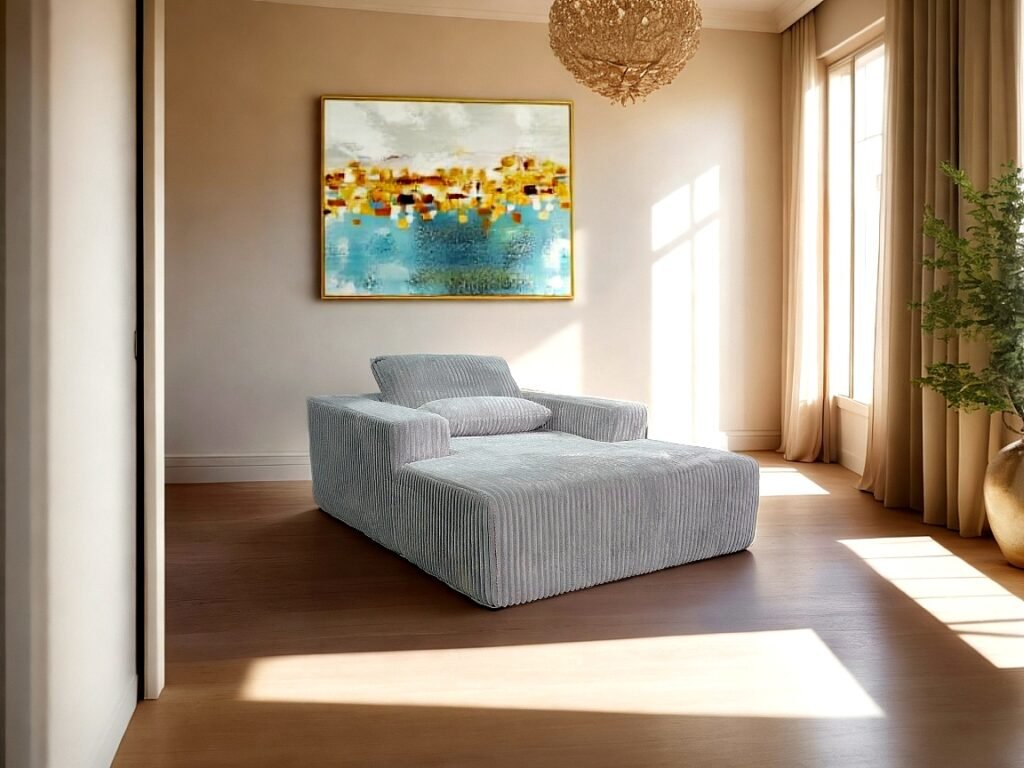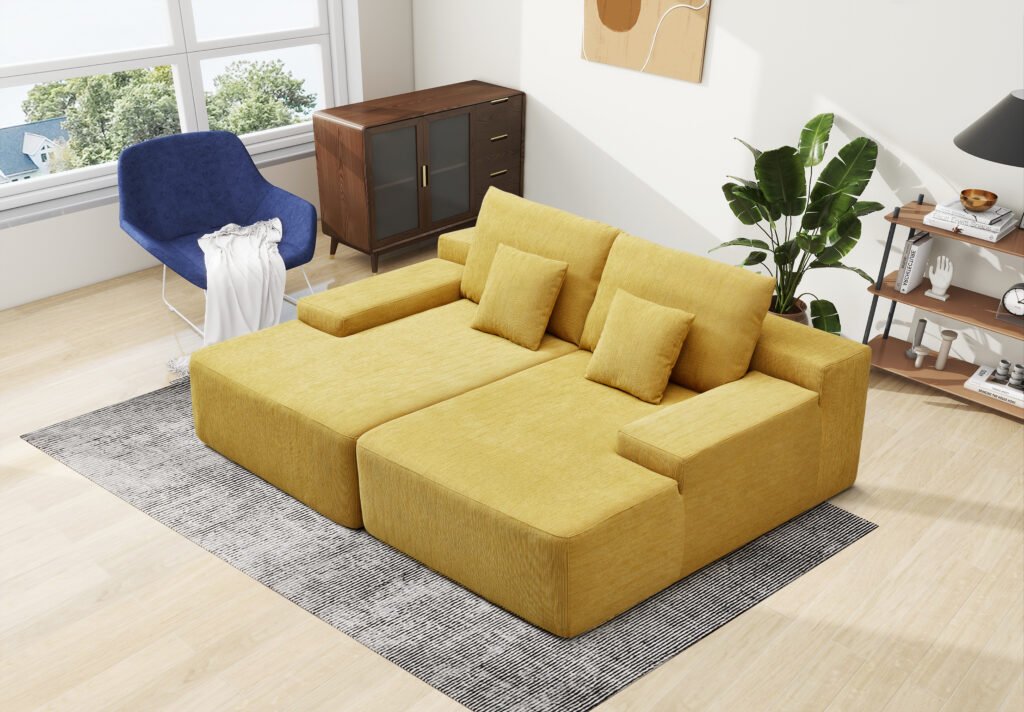In the evolving furniture market, compress sofas have gained remarkable popularity due to their innovative vacuum-compression packaging and space-saving benefits. However, one critical factor that directly influences both the performance of compression and the overall comfort of these sofas is the choice of sofa fabric. The fabric not only affects the tactile experience and durability but also plays a crucial role in how well a compress sofa withstands the compression process and maintains its aesthetic and functional integrity over time.
At Modular-Sofas.com, we understand that selecting the right fabric is essential for delivering compress sofas that combine style, comfort, and lasting performance. This article explores how different sofa fabrics impact compression performance and user comfort, guiding retailers, designers, and consumers in making informed decisions.


The Role of Sofa Fabric in Compression Sofas
Compression sofas are manufactured with high-density foam cores that allow them to be vacuum-packed and compressed into compact packages for efficient shipping and storage. Once unpacked, the sofa expands to its full size. While the foam core is critical for shape retention, the fabric upholstery must be resilient enough to endure the compression process without damage, wrinkling, or loss of texture.
The fabric also determines:
- Comfort level: softness, breathability, and temperature regulation.
- Durability: resistance to wear, tear, stains, and fading.
- Maintenance: ease of cleaning and care.
- Aesthetic appeal: texture, color retention, and style compatibility.
Choosing the wrong fabric can lead to premature wear, uncomfortable seating, or compromised compression performance.
Key Fabric Characteristics Affecting Compression Performance and Comfort
Durability and Stretchability
Fabrics used on compress sofas must withstand repeated compression and expansion cycles. Durable synthetic fibers such as polyester, olefin, and nylon offer excellent tensile strength and elasticity, allowing the fabric to stretch without tearing or permanent deformation. Fabrics with poor stretchability may wrinkle or lose shape after compression.
Breathability and Temperature Regulation
Comfort is enhanced when fabrics allow air circulation. Natural fibers like cotton and linen are highly breathable, helping regulate temperature and preventing heat buildup during prolonged seating. Some advanced synthetic blends incorporate breathable technology to mimic this effect while maintaining durability.
Softness and Texture
The tactile feel of the fabric influences the perceived comfort of the sofa. Soft fabrics such as chenille, velvet, or microfiber create a cozy and inviting surface. However, some plush fabrics may be less resistant to compression stress and require careful finishing treatments.


Stain and Water Resistance
Performance fabrics treated with stain-resistant coatings or inherently water-repellent fibers protect the sofa from spills and dirt, especially important in high-use environments. This feature also helps maintain fabric integrity after compression packaging.
Colorfastness and Fade Resistance
Compression sofas are often shipped worldwide and exposed to various environmental conditions. Fabrics with high colorfastness and UV resistance maintain their vibrant appearance over time, even after compression and unpacking.
Popular Sofa Fabrics for Compress Sofas: Features and Suitability
| Fabric Type | Composition & Features | Impact on Compression Performance | Comfort & Maintenance | Ideal Use Cases |
|---|---|---|---|---|
| Polyester | Synthetic fiber, durable, stain-resistant, low stretch | Excellent stretch and recovery, resists wrinkling | Easy to clean, moderately breathable, durable | High-traffic homes, rental properties |
| Olefin (Polypropylene) | Synthetic, moisture-wicking, stain-resistant | High elasticity, excellent compression resilience | Fade-resistant, easy care, less soft than others | Outdoor use, sunlit rooms, casual living spaces |
| Cotton | Natural fiber, breathable, soft | Moderate stretch, may wrinkle if untreated | Very breathable, comfortable, requires stain treatment | Warm climates, formal living rooms |
| Linen | Natural flax fiber, breathable, textured | Moderate stretch, prone to creasing | Breathable, cool feel, requires delicate care | Casual, eco-friendly interiors |
| Microfiber | Synthetic microfiber, soft, water-resistant | High stretch and recovery, resists compression damage | Soft, easy to clean, resists stains | Families with kids/pets, everyday use |
| Chenille | Soft, plush fabric with looped yarns | Moderate stretch, may show compression marks | Very comfortable, requires gentle maintenance | Cozy living rooms, luxury sofas |
| Velvet | Dense, plush fabric, luxurious | Moderate stretch, may crush under compression | Soft and warm, requires regular care | Formal, decorative sofas |
| Leather | Natural or faux leather, smooth surface | Low stretch, can crack if compressed improperly | Durable, easy to wipe, less breathable | Classic, high-end sofas |
How Fabric Choice Influences Compression Packaging and Expansion
The compressing and vacuum-packing process subjects the sofa fabric to intense pressure and folding. Fabrics with high elasticity and resilience recover their shape quickly and maintain smooth surfaces after expansion. In contrast, fabrics that lack stretch or have delicate textures may develop creases, wrinkles, or permanent deformation, affecting the sofa’s appearance and comfort.
Performance fabrics engineered with synthetic yarns, such as those incorporating FibreGuard technology, embed stain resistance and durability at the fiber level, ensuring consistent quality after compression. These fabrics are ideal for compress sofas because they combine longevity with easy maintenance.


Comfort Considerations Related to Fabric in Compress Sofas
Comfort is subjective but generally influenced by:
- Softness: Plush fabrics like chenille and microfiber offer a cushioned feel.
- Temperature regulation: Breathable fabrics prevent overheating.
- Texture: Smooth fabrics (leather, velvet) versus textured fabrics (linen, corduroy) affect tactile comfort.
- Allergen resistance: Synthetic fabrics often repel dust and allergens better than natural fibers.
Selecting the right fabric balances these factors with the sofa’s intended use and environment.
Maintenance and Longevity: Fabric Care for Compress Sofas
Fabrics on compress sofas must be easy to clean and maintain to preserve appearance and hygiene. Performance fabrics with stain-resistant finishes reduce the need for professional cleaning, while natural fibers may require more delicate care. Additionally, fabrics that resist fading and pilling extend the sofa’s lifespan, especially important for compressed packaging and shipping conditions.
Why Modular-Sofas.com Prioritizes Fabric Innovation
At Modular-Sofas.com, our compress sofas are crafted using carefully selected fabrics that optimize compression performance and comfort. We collaborate with leading fabric manufacturers to source materials that combine:
- High durability and elasticity for compression resilience.
- Superior comfort with breathable, soft textures.
- Easy maintenance with stain and fade resistance.
- Stylish aesthetics aligned with modern interior trends.
Our commitment ensures customers receive compress sofas that look great, feel comfortable, and maintain their quality through shipping and everyday use.
Summary Table: Sofa Fabric Impact on Compression Performance and Comfort
| Fabric Type | Compression Resilience | Comfort Level | Maintenance Ease | Durability | Best Application |
|---|---|---|---|---|---|
| Polyester | Excellent | Moderate | Easy | High | High-use, budget-conscious |
| Olefin | Excellent | Moderate | Easy | Very High | Outdoor, sun-exposed areas |
| Cotton | Moderate | High | Moderate | Moderate | Breathable, natural feel |
| Linen | Moderate | High | Delicate | Moderate | Casual, eco-friendly |
| Microfiber | High | High | Easy | High | Families, pets |
| Chenille | Moderate | Very High | Moderate | Moderate | Luxury, cozy settings |
| Velvet | Moderate | Very High | Delicate | Moderate | Formal, decorative |
| Leather | Low | Moderate | Easy | Very High | Classic, elegant |
Conclusion
The choice of sofa fabric is a pivotal factor influencing both the compression performance and comfort of compress sofas. Fabrics that combine elasticity, durability, and softness enable sofas to withstand vacuum compression packaging without compromising aesthetics or user experience. Performance fabrics, microfiber, and certain synthetics excel in balancing these demands, while natural fibers offer superior breathability and comfort but may require more care.
For retailers and consumers seeking compress sofas that deliver on style, comfort, and longevity, understanding fabric properties is essential. Modular-Sofas.com is dedicated to providing compress sofas upholstered with fabrics that meet these rigorous standards, ensuring a premium product that performs beautifully from packaging to everyday use.
If you would like, we can provide further detailed sections on fabric technology, care guides, or case studies showcasing our compress sofa collections.